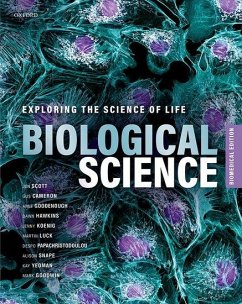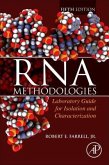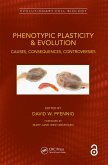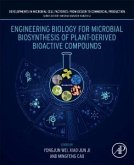Jon Scott (Emeritus Pro Emeritus Professor of Bioscience Education, Gus Cameron (School of Bioc Reader in Biomedical Science Education, Anne Goodenough (Professor in Applied Professor in Applied Ecology
Biological Science
Exploring the Science of Life, Biomedical Edition
Jon Scott (Emeritus Pro Emeritus Professor of Bioscience Education, Gus Cameron (School of Bioc Reader in Biomedical Science Education, Anne Goodenough (Professor in Applied Professor in Applied Ecology
Biological Science
Exploring the Science of Life, Biomedical Edition
- Broschiertes Buch
- Merkliste
- Auf die Merkliste
- Bewerten Bewerten
- Teilen
- Produkt teilen
- Produkterinnerung
- Produkterinnerung
A fresh approach to biology centred on a clear narrative, active learning, and confidence with quantitative concepts and scientific enquiry. Designed for flexible learning, it will give you a deeper understanding of the key concepts, and an appreciation of biology as a dynamic experimental science.
Andere Kunden interessierten sich auch für
![Anandamide in Health and Disease Anandamide in Health and Disease]() Anandamide in Health and Disease183,99 €
Anandamide in Health and Disease183,99 €![RNA Methodologies RNA Methodologies]() Farrell, Robert E., Jr. (Pennsylvania State University, York, PA, USRNA Methodologies156,99 €
Farrell, Robert E., Jr. (Pennsylvania State University, York, PA, USRNA Methodologies156,99 €![Cellular Dialogues in the Holobiont Cellular Dialogues in the Holobiont]() Cellular Dialogues in the Holobiont162,99 €
Cellular Dialogues in the Holobiont162,99 €![Phenotypic Plasticity & Evolution Phenotypic Plasticity & Evolution]() Phenotypic Plasticity & Evolution103,99 €
Phenotypic Plasticity & Evolution103,99 €![Transformer Transformer]() Nick LaneTransformer20,99 €
Nick LaneTransformer20,99 €![Transformer Transformer]() Nick LaneTransformer32,99 €
Nick LaneTransformer32,99 €![Engineering Biology for Microbial Biosynthesis of Plant-Derived Bioactive Compounds Engineering Biology for Microbial Biosynthesis of Plant-Derived Bioactive Compounds]() Engineering Biology for Microbial Biosynthesis of Plant-Derived Bioactive Compounds172,99 €
Engineering Biology for Microbial Biosynthesis of Plant-Derived Bioactive Compounds172,99 €-
-
-
A fresh approach to biology centred on a clear narrative, active learning, and confidence with quantitative concepts and scientific enquiry. Designed for flexible learning, it will give you a deeper understanding of the key concepts, and an appreciation of biology as a dynamic experimental science.
Hinweis: Dieser Artikel kann nur an eine deutsche Lieferadresse ausgeliefert werden.
Hinweis: Dieser Artikel kann nur an eine deutsche Lieferadresse ausgeliefert werden.
Produktdetails
- Produktdetails
- Verlag: Oxford University Press
- Seitenzahl: 1000
- Erscheinungstermin: 8. November 2022
- Englisch
- Abmessung: 278mm x 221mm x 40mm
- Gewicht: 2192g
- ISBN-13: 9780198783695
- ISBN-10: 0198783698
- Artikelnr.: 62429753
- Herstellerkennzeichnung
- Libri GmbH
- Europaallee 1
- 36244 Bad Hersfeld
- gpsr@libri.de
- Verlag: Oxford University Press
- Seitenzahl: 1000
- Erscheinungstermin: 8. November 2022
- Englisch
- Abmessung: 278mm x 221mm x 40mm
- Gewicht: 2192g
- ISBN-13: 9780198783695
- ISBN-10: 0198783698
- Artikelnr.: 62429753
- Herstellerkennzeichnung
- Libri GmbH
- Europaallee 1
- 36244 Bad Hersfeld
- gpsr@libri.de
Life and its Exploration: Foundational Principles
Topic 1: Exploring the science of life
Topic 2: The emergence of life on Earth
Topic 3: Defining Life
Topic 4: Evolutionary processes
Topic 5: The diversity, organisation, and classification of life
Quantitative Toolkits
Quantitative Toolkit 1: Understanding data
Quantitative Toolkit 2: Size and scale
Quantitative Toolkit 3: Describing data
Quantitative Toolkit 4: Ratio and proportion
Quantitative Toolkit 5: Understanding samples
Quantitative Toolkit 6: Designing experiments
Quantitative Toolkit 7: Assessing patterns
Quantitative Toolkit 8: Formulae and equations
Quantitative Toolkit 9: Rates of change
Module 1 LIFE AT THE MOLECULAR LEVEL
1: Building blocks: molecules and macromolecules
2: Energy: powering biochemical processes
3: Information: genes and genomes
4: Mendelian genetics
5: Reading the genome: gene expression and protein synthesis
6: Proteins and proteomes
7: Metabolism: energy capture and release from food
8: Molecular tools and techniques
Module 2 LIFE AT THE CELLULAR LEVEL
9: Characteristics of prokaryotic and eukaryotic cells
10: Cell division in prokaryotes and eukaryotes
11: Microbial diversity
12: The growth, measurement, and visualisation of cells
13: Microbes in life: harnessing their power
14: Microbes as agents of infectious disease
15: Viruses
Module 3 THE HUMAN ORGANISM: TISSUES, ORGANS, AND SYSTEMS
16: Physiology overview
17: Communication and control 1: introducing the nervous and endocrine systems
18: Communication and control 2: sensory systems
19: Communication and control 3: controlling organ systems
20: Muscle and movement
21: Cardiovascular system
22: Respiratory system
23: Exercise physiology
24: Renal system
25: Digestive system
26: Reproductive system
27: Immune system
Topic 1: Exploring the science of life
Topic 2: The emergence of life on Earth
Topic 3: Defining Life
Topic 4: Evolutionary processes
Topic 5: The diversity, organisation, and classification of life
Quantitative Toolkits
Quantitative Toolkit 1: Understanding data
Quantitative Toolkit 2: Size and scale
Quantitative Toolkit 3: Describing data
Quantitative Toolkit 4: Ratio and proportion
Quantitative Toolkit 5: Understanding samples
Quantitative Toolkit 6: Designing experiments
Quantitative Toolkit 7: Assessing patterns
Quantitative Toolkit 8: Formulae and equations
Quantitative Toolkit 9: Rates of change
Module 1 LIFE AT THE MOLECULAR LEVEL
1: Building blocks: molecules and macromolecules
2: Energy: powering biochemical processes
3: Information: genes and genomes
4: Mendelian genetics
5: Reading the genome: gene expression and protein synthesis
6: Proteins and proteomes
7: Metabolism: energy capture and release from food
8: Molecular tools and techniques
Module 2 LIFE AT THE CELLULAR LEVEL
9: Characteristics of prokaryotic and eukaryotic cells
10: Cell division in prokaryotes and eukaryotes
11: Microbial diversity
12: The growth, measurement, and visualisation of cells
13: Microbes in life: harnessing their power
14: Microbes as agents of infectious disease
15: Viruses
Module 3 THE HUMAN ORGANISM: TISSUES, ORGANS, AND SYSTEMS
16: Physiology overview
17: Communication and control 1: introducing the nervous and endocrine systems
18: Communication and control 2: sensory systems
19: Communication and control 3: controlling organ systems
20: Muscle and movement
21: Cardiovascular system
22: Respiratory system
23: Exercise physiology
24: Renal system
25: Digestive system
26: Reproductive system
27: Immune system
Life and its Exploration: Foundational Principles
Topic 1: Exploring the science of life
Topic 2: The emergence of life on Earth
Topic 3: Defining Life
Topic 4: Evolutionary processes
Topic 5: The diversity, organisation, and classification of life
Quantitative Toolkits
Quantitative Toolkit 1: Understanding data
Quantitative Toolkit 2: Size and scale
Quantitative Toolkit 3: Describing data
Quantitative Toolkit 4: Ratio and proportion
Quantitative Toolkit 5: Understanding samples
Quantitative Toolkit 6: Designing experiments
Quantitative Toolkit 7: Assessing patterns
Quantitative Toolkit 8: Formulae and equations
Quantitative Toolkit 9: Rates of change
Module 1 LIFE AT THE MOLECULAR LEVEL
1: Building blocks: molecules and macromolecules
2: Energy: powering biochemical processes
3: Information: genes and genomes
4: Mendelian genetics
5: Reading the genome: gene expression and protein synthesis
6: Proteins and proteomes
7: Metabolism: energy capture and release from food
8: Molecular tools and techniques
Module 2 LIFE AT THE CELLULAR LEVEL
9: Characteristics of prokaryotic and eukaryotic cells
10: Cell division in prokaryotes and eukaryotes
11: Microbial diversity
12: The growth, measurement, and visualisation of cells
13: Microbes in life: harnessing their power
14: Microbes as agents of infectious disease
15: Viruses
Module 3 THE HUMAN ORGANISM: TISSUES, ORGANS, AND SYSTEMS
16: Physiology overview
17: Communication and control 1: introducing the nervous and endocrine systems
18: Communication and control 2: sensory systems
19: Communication and control 3: controlling organ systems
20: Muscle and movement
21: Cardiovascular system
22: Respiratory system
23: Exercise physiology
24: Renal system
25: Digestive system
26: Reproductive system
27: Immune system
Topic 1: Exploring the science of life
Topic 2: The emergence of life on Earth
Topic 3: Defining Life
Topic 4: Evolutionary processes
Topic 5: The diversity, organisation, and classification of life
Quantitative Toolkits
Quantitative Toolkit 1: Understanding data
Quantitative Toolkit 2: Size and scale
Quantitative Toolkit 3: Describing data
Quantitative Toolkit 4: Ratio and proportion
Quantitative Toolkit 5: Understanding samples
Quantitative Toolkit 6: Designing experiments
Quantitative Toolkit 7: Assessing patterns
Quantitative Toolkit 8: Formulae and equations
Quantitative Toolkit 9: Rates of change
Module 1 LIFE AT THE MOLECULAR LEVEL
1: Building blocks: molecules and macromolecules
2: Energy: powering biochemical processes
3: Information: genes and genomes
4: Mendelian genetics
5: Reading the genome: gene expression and protein synthesis
6: Proteins and proteomes
7: Metabolism: energy capture and release from food
8: Molecular tools and techniques
Module 2 LIFE AT THE CELLULAR LEVEL
9: Characteristics of prokaryotic and eukaryotic cells
10: Cell division in prokaryotes and eukaryotes
11: Microbial diversity
12: The growth, measurement, and visualisation of cells
13: Microbes in life: harnessing their power
14: Microbes as agents of infectious disease
15: Viruses
Module 3 THE HUMAN ORGANISM: TISSUES, ORGANS, AND SYSTEMS
16: Physiology overview
17: Communication and control 1: introducing the nervous and endocrine systems
18: Communication and control 2: sensory systems
19: Communication and control 3: controlling organ systems
20: Muscle and movement
21: Cardiovascular system
22: Respiratory system
23: Exercise physiology
24: Renal system
25: Digestive system
26: Reproductive system
27: Immune system








